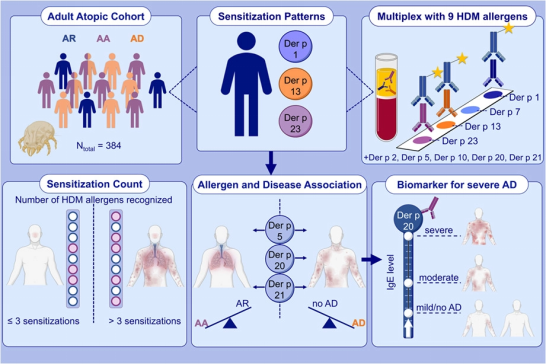Release date:2023-03-13

Allergy
[IF:13.146]
Specific IgE against the house dust mite allergens Der p 5, 20 and 21 influences the phenotype and severity of atopic diseasesDOI: 10.1111/all.15553
Abstract:
Background: House dust mites (HDM) are among the most important sources for airborne allergens with high relevance for atopic diseases. Routine tests contain only 4 of 32 registered allergens of Dermatophagoides pteronyssinus. Clinical relevance and pathomechanistic properties of many allergens are not well understood.
Objective: The association of several HDM allergens with allergic rhinitis, allergic asthma, and atopic dermatitis was investigated to identify allergens with biomarker potential and to transfer them into diagnostics.
Methods: Eight out of nine D. pteronyssinus allergens (nDer p 1, rDer p 2, rDer p 5, rDer p 7, rDer p 10, rDer p 13, rDer p 20, rDer p 21, rDer p 23) were recombinantly expressed and purified. Sensitization patterns of 384 HDM-allergic individuals exhibiting different clinical phenotypes were analyzed with a serum-saving multiplex array.
Results: Sensitization to more than three mite allergens (sensitization count) was associated with allergic asthma and/or atopic dermatitis. Reactions to Der p 5 and Der p 21 were more frequent in allergic asthma compared to allergic rhinitis. Atopic dermatitis patients were more often sensitized to Der p 5, Der p 20, and Der p 21 among others. Der p 20-IgE> 80 kU/L was associated with severe atopic dermatitis in 75% of patients.
Conclusion: This study demonstrates the clinical importance of the sensitization count and of certain allergens (Der p 5, Der p 20, and Der p 21) not available for routine diagnostics yet. Implementing them as well as the sensitization count in diagnostic measures will improve diagnosis and risk assessment of HDM-allergic patients.
First Author:
Theresa Walsemann
Corresponding author
Uta Jappe
Correspondence:
Uta Jappe, Division of Clinical and Molecular Allergology, Research Center Borstel, Leibniz Lung Center, Parkallee 35,23845 Borstel, Germany.
 杭州浙大迪迅生物基因工程有限公司
杭州浙大迪迅生物基因工程有限公司
